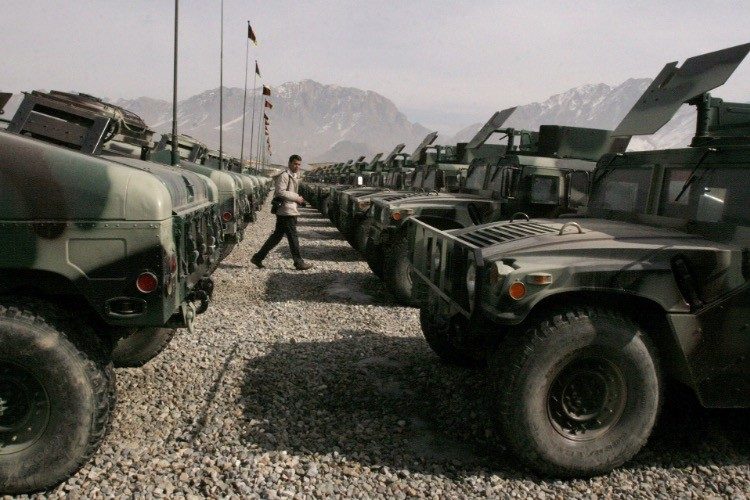
The Biden administration has failed so absolutely in various sectors of the Afghanistan withdrawal that the sheer mass of the whole can obfuscate specific instances of gross negligence. An example of this would be the scale of abandoned gear, weapons, and vehicles U.S. forces have left behind. To the media’s credit, the focus has been on the herculean efforts of private entities and the military to get contractors, U.S. citizens, and Afghan SIVs (Special Immigrant Visa holders) out of the country. What’s more, those on the ground and piloting the aircraft must work around the ineffectual bureaucrats, who are their commanders and political leaders.
With our priorities acknowledged — people before pistols — the billions of dollars of US taxpayers’ dollars in the form of armored vehicles, weapons systems, and communications equipment now in the hands of an enemy force is contemptible. Perhaps even worse is the administration’s seeming cover-up of the exact figures regarding this missing material.
Adam Andrzejewski of Forbes did a manful job this past week exposing a number of the administration’s specious claims. Audits of military gear in Afghanistan have been pulled from the Government Accountability Office’s website because “the State Department requested we temporarily remove and review reports on Afghanistan to protect recipients of U.S. assistance that may be identified through our reports and thus subject to retribution,” according to a GAO spokesman. However, as Andrzejewski notes, “these reports only have numbers and no recipient information.”
What information is available to the interested public is from 2017 and earlier and would not be available if not for the foresight of OpenTheBooks.com — a government watchdog — downloading the documents and reposting them to their website, here.
The numbers defy conception. 76,000 vehicles, 22,000 of which were Humvees. 160,000 radios. 600,000 weapons — 350,000 rifles numbering among these. While the numbers can be too large to comprehend, what is possible to grasp is the Taliban purportedly flying over Kandahar in an abandoned Blackhawk helicopter.
The costs for just the land vehicles break down as follows, provided by Andrzejewski:
- Armored personnel carriers such as the M113A2 cost $170,000 each, and recent purchases of the M577A2 post carrier cost $333,333 each.
- Mine resistant vehicles ranges from $412,000 to $767,000. The total cost could range between $382 million to $711 million.
- Recovery vehicles such as the ‘truck, wrecker’ cost between for the base model $168,960 and $880,674 for super strength versions.
- Medium range tactical vehicles include five-ton cargo and general transport trucks were priced at $67,139. However, the family of MTV heavy vehicles had prices ranging from $235,500 to $724,820 each. Cargo trucks to transport airplanes cost $800,865.
- Humvees — ambulance type (range from $37,943 to $142,918 with most at $96,466); cargo type, priced at $104,682. Utility Humvees were typically priced at $91,429. However, the 12,000 lb. troop transport version cost up to $329,000.
- Light tactical vehicles: Fast attack combat vehicles ($69,400); and passenger motor vehicles ($65,500). All terrain four-wheel vehicles go up to $42,273 in the military databases.
And on and on it goes for the weapons, aircraft, and sundry other items that make up warfighting logistics in the modern age. But what does it all mean?
This is the most difficult to know, as we have records of what we have provided but little knowledge of what still exists in working order. Aircraft and vehicles — such as the Humvee — are maintenance-intensive and of little battlefield value to the Taliban. They’ll quickly find them onerously expensive, as only the finest products of the military-industrial complex can be. Long-term, the value in these vehicles for the Taliban will be chopping them up for parts to sell. The vehicles such as the Black Hawk and Humvees now parading around are doing precisely that, parading for morale effect.
Here the Biden administration’s pusillanimity is most evident. They have backed themselves out of Afghanistan in precisely the wrong order, pulling military resources before the contractors and the materiel.
While the Trump administration had its missteps regarding Afghanistan, Biden’s claims that his predecessor forced his hand into this withdrawal approach ring hollow, especially given how he was more than willing to unwind many of his predecessor’s agreements executive orders within days of assuming office. This disastrous extirpation of US influence from Afghanistan rests upon the stooped shoulders of Joe Biden; such is the cost of being the supreme executive. Now the American people must come to grips with a diminished reputation abroad, the reality of many Afghan refugees coming to the United States, whether it be best for the refugees or citizenry — when compared to resettlement in more culturally similar countries, and the deaths of American sons and daughters in a war that ended in abject humiliation.


